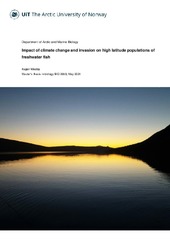Impact of climate change and invasion on high latitude populations of freshwater fish
Permanent link
https://hdl.handle.net/10037/37078Date
2024-05-15Type
Master thesisMastergradsoppgave
Author
Westby, AsgeirAbstract
Rapid climate change significantly impacts high-latitude freshwater ecosystems, altering thermal regimes and ecological dynamics. This study examines the lakes Vaggatem and Skrukkebukta in Pasvik in Northern Norway, where recent decades have seen average increases in surface water temperatures of 0.45°C per decade, accompanied by a modelled 0.07°C decadal rise in hypolimnetic water temperatures, intensifying lake stratification and altering habitat conditions for key fish species. Notably, habitat use by vendace (Coregonus albula) and densely rakered whitefish (Coregonus lavaretus, DRW) influences exposure to these thermal shifts, with vendace occupying warmer epilimnetic layers and whitefish increasingly found in colder hypolimnetic zones, due to competitive displacement and predation avoidance strategies. The thermal preferences of vendace allow it to benefit from higher temperatures in the epilimnion, showing enhanced growth rates facilitated by elevated ingestion rates. Conversely, whitefish are disadvantaged by their shift to colder waters, where lower ingestion rates limit their growth potential. This competitive displacement may exacerbate differences in growth performance between the species under warming scenarios. Regression models relating length-at-age and size increments to water temperature have confirmed these trends, underscoring the direct impact of climatic variability on fish physiology. Temperature trends in the region align with global observations of heightened thermal alterations in freshwater lakes, characterized by increased seasonal mean temperatures and corresponding shifts in water thermal stratification. These changes, coupled with the lengthened warm periods and modified ice phenology, suggest a transition to sharply dimictic stratification patterns, profoundly influencing nutrient cycles, oxygen levels and overall lake ecology. This study highlights the compounding interplay between temperature rise and invasive species, revealing significant cumulative impact on native fish populations with implications for high-latitude freshwater ecosystems. The findings stress the need for adaptive management strategies that consider the ecological responses of aquatic species to ongoing environmental changes.
Publisher
UiT Norges arktiske universitetUiT The Arctic University of Norway
Metadata
Show full item recordCollections
Copyright 2024 The Author(s)
The following license file are associated with this item:


 English
English norsk
norsk
